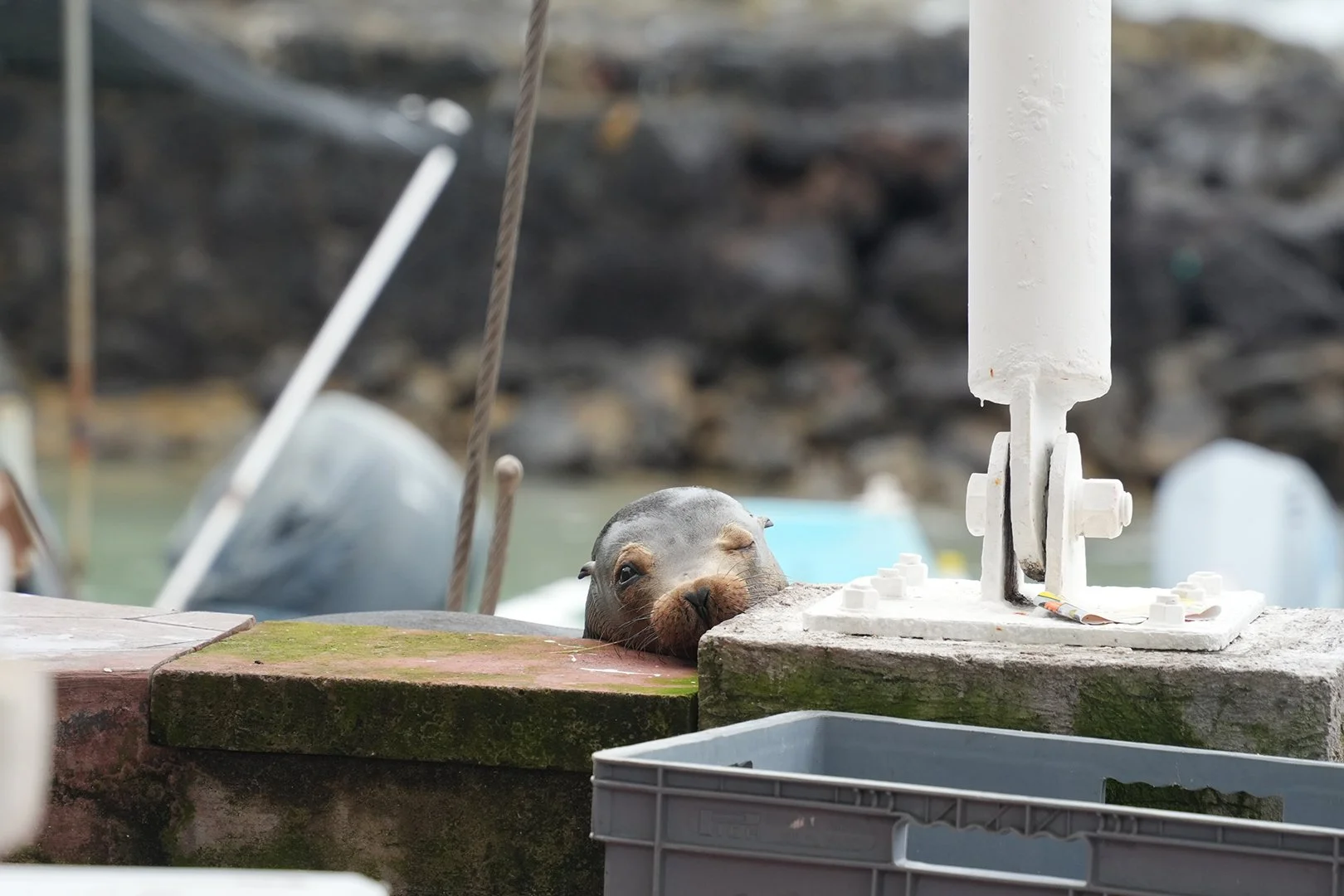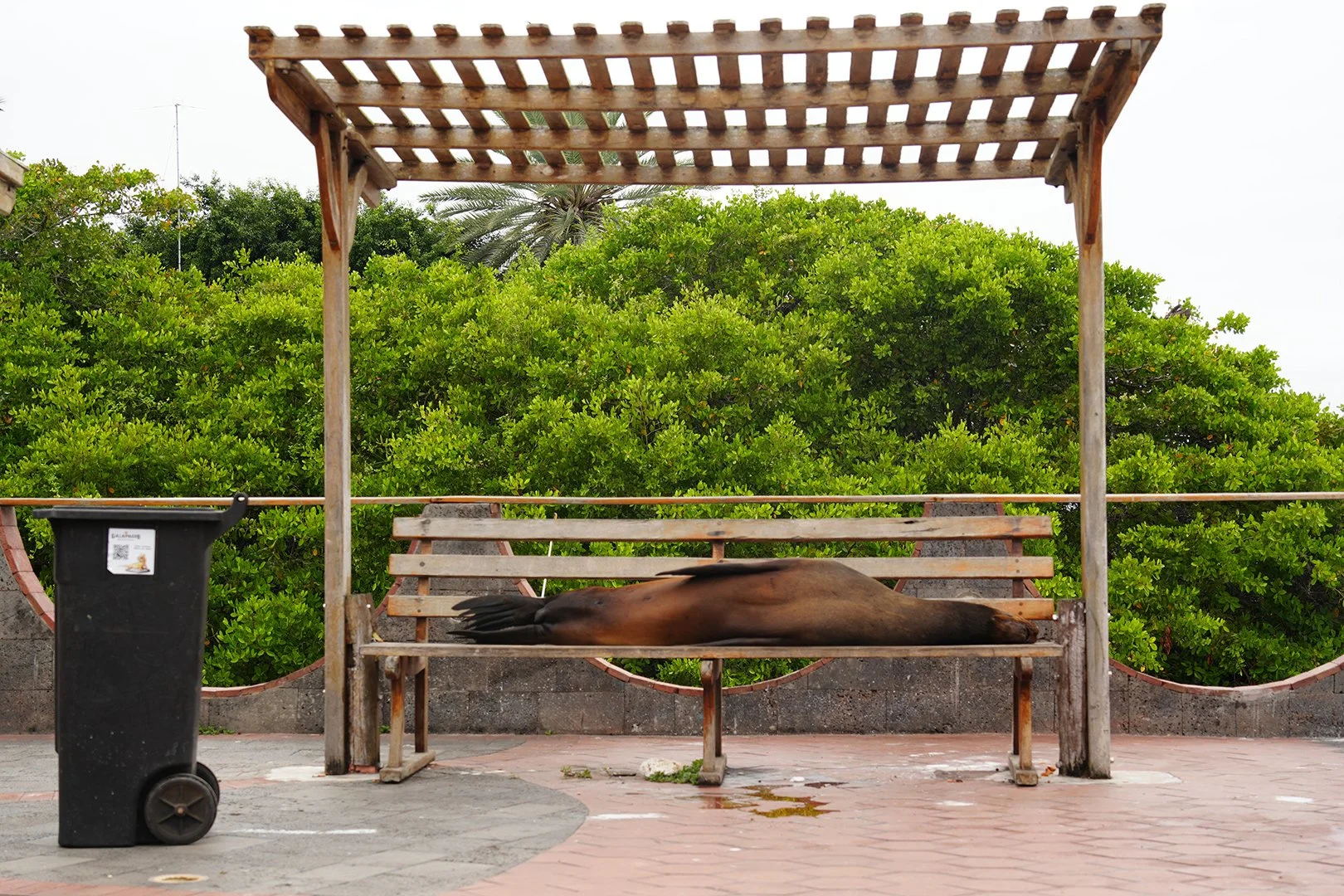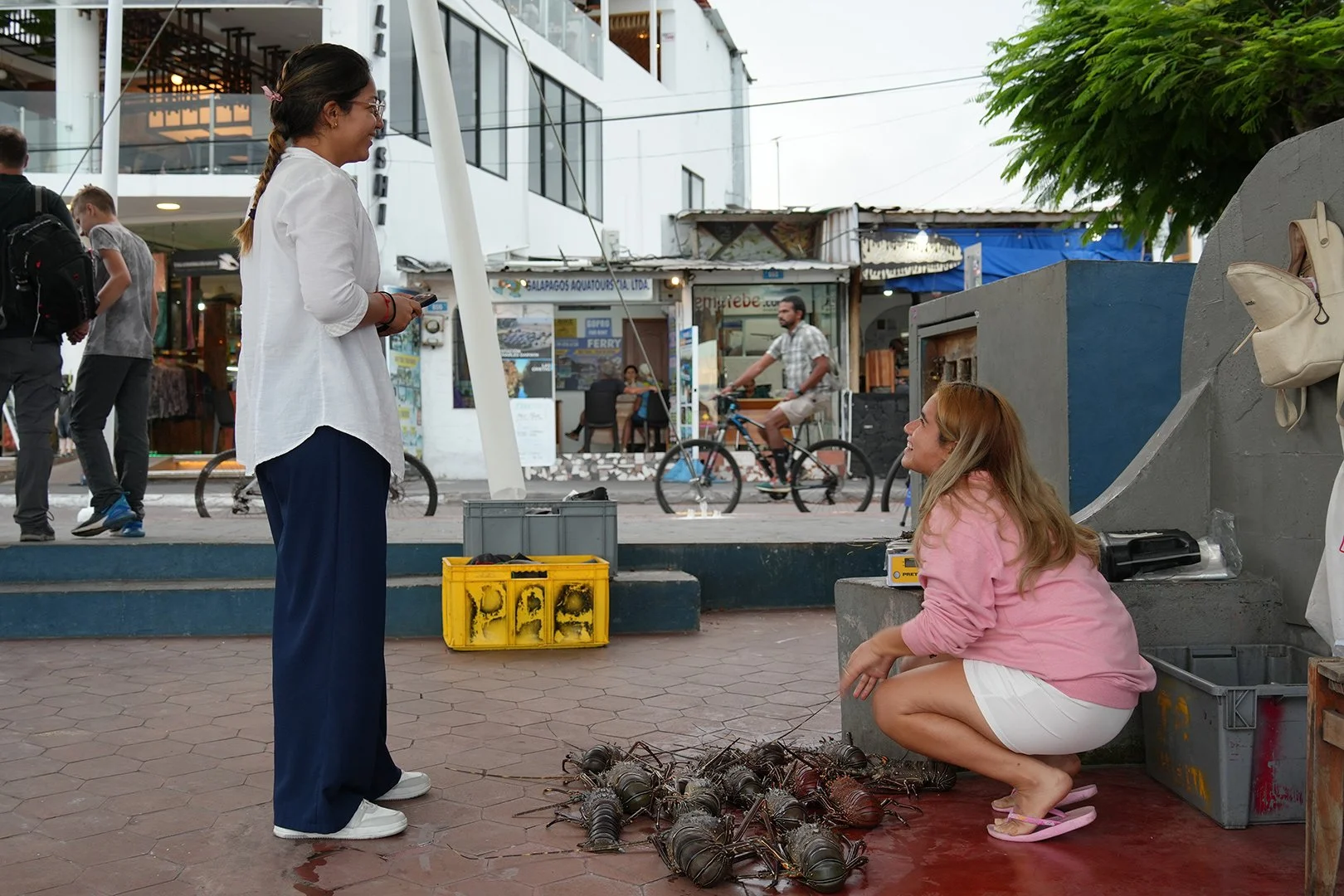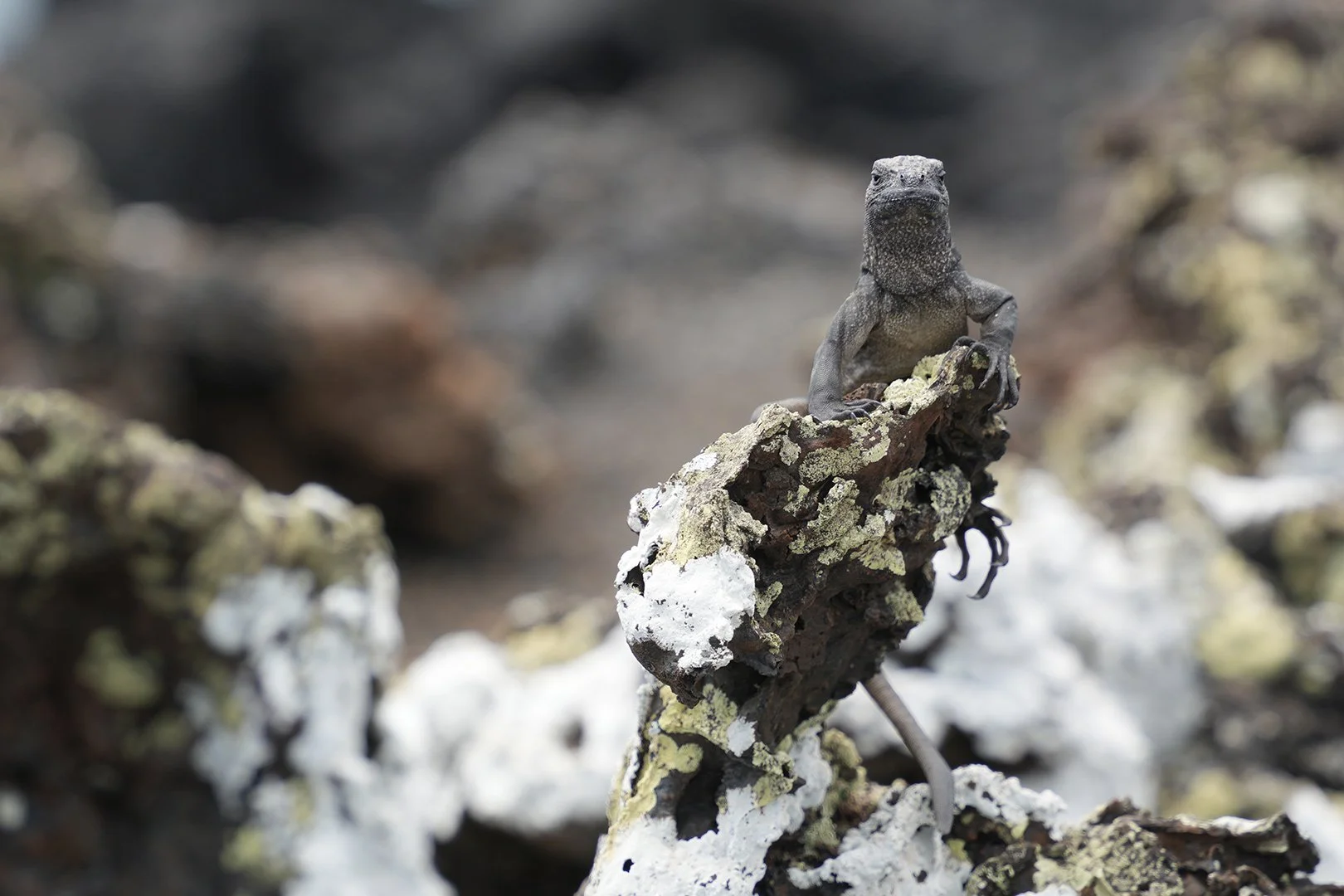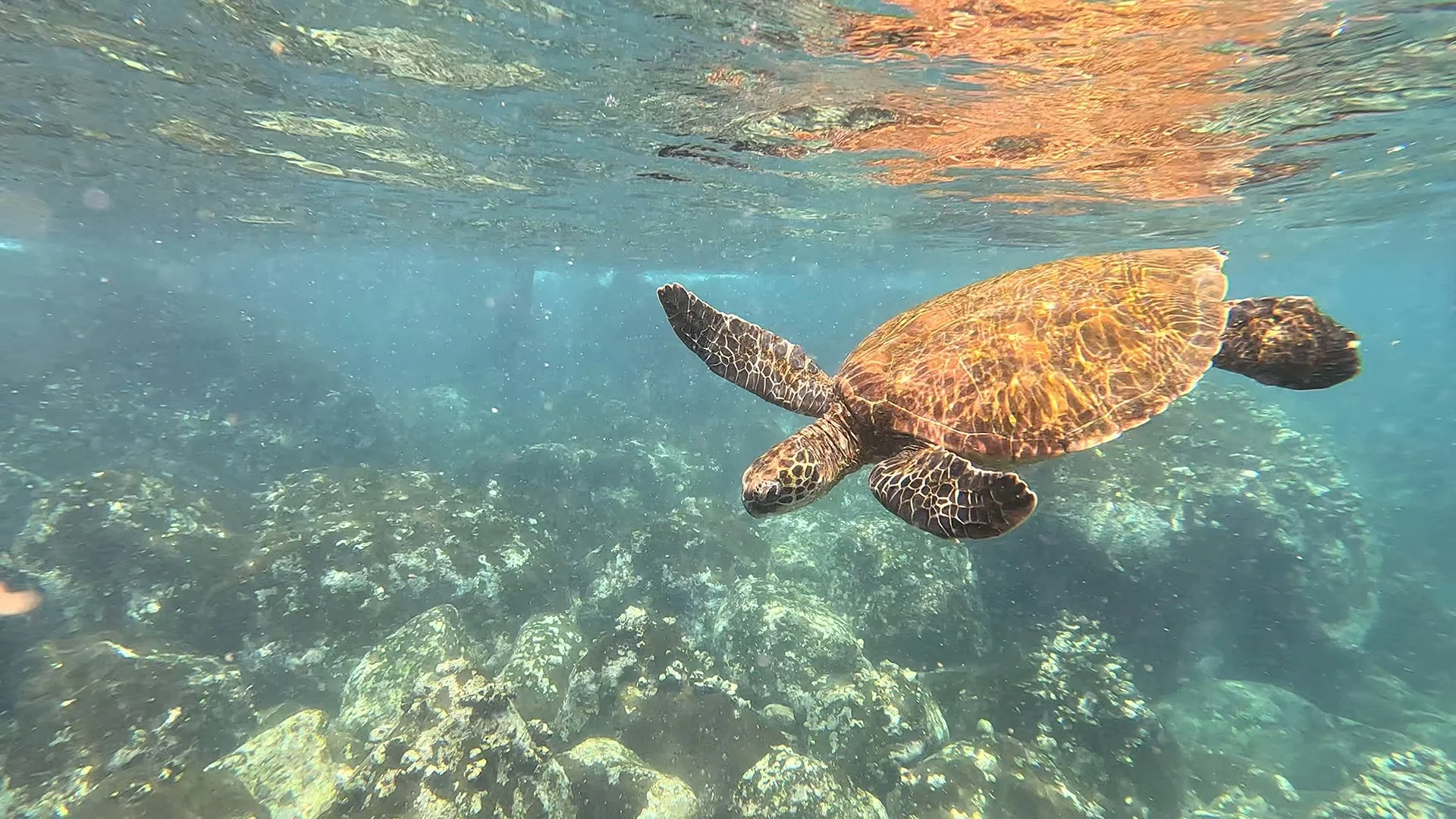The marred fantasy of ‘pristine nature’ in Galápagos
By Safina Center Environmental Journalism Fellow Marlowe Starling
A Galápagos sea lion rests its head on a ledge at the fishing pier in Puerto Ayora, Santa Cruz, waiting for fish scraps. ©Marlowe Starling
Reaching the Galápagos islands is no easy feat, but easier than I expected. A flight from Quito, Ecuador’s capital, to Baltra Island gets you to the Galápagos. Then, you present your documents, pay your entry fee, and scan your bag through security. Afterward, you can get to the main island, Santa Cruz, by a bus to a ferry to a taxi and, if you’re staying on an island other than Santa Cruz, to another ferry.
I had the opportunity to experience this navigational adventure in July, too in shock to fully absorb the fact that I was indeed visiting a place that seemed—at least in wildlife documentaries on TV—untouchable. I marveled at the brightly colored crabs on the docks, at the sea lions casually sun bathing suspiciously close to humans, and at the turquoise-tinted water in stark contrast to the dark lava-molded rocks. I fantasized about the marine iguanas I would see nibbling algae off coral, and I salivated at the thought of all the fresh, locally sourced fish I was bound to eat for the next five days.
Safina Center Environmental Journalism Fellow Marlowe Starling sits at the official Santa Cruz, Galápagos sign at Puerto Ayora. ©Marlowe Starling
For most of my visit, this image stuck with me. But one morning, as I sat at the fishing pier to speak with a fisherwoman who was selling a beautiful bunch of fat, colorful lobsters — one weighing a hefty eight pounds—I thought to myself: See! This is what happens when we properly manage our natural resources.
I couldn’t have been more wrong.
You don’t need to go far to see animals that aren’t found anywhere else in the world. Even in the Galápagos’ busiest location—where dozens of restaurants and gift shops are lined up along the waterfront—sea lions wait for fish scraps at the fishing dock and nap on urban park benches while throngs of juvenile marine iguanas bask in the sun on pedestrian sidewalks.
A Galápagos sea lion (Zalophus wollebaeki), and endangered species on the IUCN Red List, snoozes on a public bench at Puerto Ayora, Santa Cruz. ©Marlowe Starling
Like most tourist economies, Galápagos is ridden with street vendors selling artwork, shops selling collections of kitschy knick-knacks, and tour guides selling the most memorable experience of your life. You’ll swim with sea lions (I did, actually), you’ll take photos that promise to make your ex jealous, and most spectacularly of all, you will have touched an untouched paradise.
The problem is that the Galápagos islands aren’t “untouched” at all. This shouldn’t come as a surprise—that a place with world-famous biodiversity would base its entire economy around it, inviting mainland Ecuadorians and expats alike to settle into the island life, pick up artisanal fishing, set up shop on the street, start a tour company, and otherwise base their entire income around the one thing tourists are willing to pay for: a touch of untouched paradise.
“we cannot expect to experience an untouched wilderness that simply does not exist.”
This illusion, however, masks a much lesser-known challenge within the Galápagos Marine Reserve.
“Not a single fishery is well managed in Galápagos—not one resource,” Alex Hearn, a marine biologist at the Universidad San Francisco de Quito, told me over the phone.
It’s a sobering statement. I thought back to the eight-pound lobsters I had seen at Puerto Ayora, realizing that the reason I had only seen two or three fishermen on the dock all those mornings was because most of them now use a different location to avoid tourists. The lobster fisher I spoke with comes from a family history of fishing—her father and grandfather—and I watched them sell their catch directly to the high-end restaurants across the street. But not all of Galápagos’ artisanal fishers sell their catch locally. Much of it is exported, Hearn told me.
Valeria Ascencio, a generational artisanal lobster fisher in the Galápagos, speaks with a potential client at the Puerto Ayora fishing dock on Santa Cruz island. ©Marlowe Starling
A large Galápagos spiny lobster sits on a scale for sale at Puerto Ayora, Santa Cruz. Some species, such as the slipper lobster (different than the species pictured here), have been overfished. ©Marlowe Starling
Take the brown sea cucumber (Isostichopus fuscus), for instance, which is highly prized for luxury cuisine and traditional Chinese medicine, making the local species a high-dollar international commodity. In the early 2000s, sea cucumbers frequented the marine reserve’s seafloor at an average density of 160 animals per 100 square meters, Hearn told me. Over time, it dwindled: 100, 45, 27, and today, just 11.
“Now, when sea cucumber density goes up from 10 to 11, everyone cheers [that] there's been a recovery,” Hearn said. “But we've forgotten that when it was 45, we thought it was bad.”
Even locally caught species, he added, aren’t always locally caught.
“Did you ever ask in the restaurants, when you ordered tuna, how that tuna was actually caught?” Hearn asked me over the phone.
“No,” I answered honestly.
“No, because you assume that, because of artisanal fishing, that it’s in the marine reserve,” he said. He was right; I did assume that. “But there's about 100 fishermen that are using longlines, which are illegal.”
Longlines are a type of deep-sea fishing gear that consists of a very long line of baited hooks that is usually anchored to the seafloor. The method is notorious for bycatch, when non-target species such as marine mammals get caught by accident and die. Swordfish, Hearn posits, are also caught this way and exported to the global market.
“Galápagos has shown us…that as soon as you have a local commodity for a global market, you lose control of your resource,” Hearn said. “Global markets are voracious and insatiable.”
Meanwhile, others are both exploited and exported. Endemic slipper lobsters (Scyllarides astori) are on the brink of collapse according to Hearn and other scientists. The law allows each person to send five lobsters by mail, such as to a family member in Quito — not for commercial sale. But now, fishers have identified a loophole by using friends’ ID cards to send dozens of them to the mainland for commercial sale.
Overfishing doesn’t just deplete single populations; it affects the entire food chain. With fewer slipper lobsters, sea urchins—their main prey—are now growing unfettered in some areas, said Tui de Roy, a longtime resident of the islands who spoke with me. Sea urchins eat algae, which has increased competition with the marine iguanas that also eat algae, she explained.
A juvenile marine iguana sits atop the lava-rock formations on Isabela island. ©Marlowe Starling
Artisanal fishing in Galápagos has roughly tripled since the early 1990s, Hearn said, which is in part to blame for the pressures on these commercially viable species.
“We have an over-capitalized fishing sector, and we just keep racing forward, looking for more things that they can exploit to keep going,” he said.
Hearn and Roy warn about blaming outsiders for these problems—that locals are just as implicated in overfishing as the industrial fishing fleets just beyond the marine reserve’s boundary. But it would be unfair to entirely fault the local population for this reality.
As Hearn told me: “I would argue that the biggest problem in Galápagos is incredibly weak governance.” Galápagos National Park is responsible for regulating and governing artisanal fishing within the marine reserve. But with a high turnover rate in leadership and questionable regulations, overfishing remains a main problem, according to Hearn and Roy.
A green sea turtle floats through turquoise waters off the coast of Santa Fe island. ©Marlowe Starling
A common reaction to this reality is disappointment. “If not there, then where?” some friends and family members said to me, with a sigh. It’s true that while the Galápagos are conserved far better than most places on earth, it’s not a golden standard. The Galápagos may not be a shining example, but they are a key example of the pressure our species has placed on the forces of life that sustain us.
We cannot have unexploited wilderness if livelihoods are not met. We cannot have well-managed fisheries when corruption, greed, and profits are at the fingertips of people with unchecked power. And we cannot expect to experience an untouched wilderness that simply does not exist.
The wonder instilled by the islands’ wildlife still cannot be understated. I think back to the moment when a sea lion pup came up to my GoPro, bumping its nose to the camera lens in a magical moment preserved forever in a digital file. I think about the sheer size of the sea turtles I floated over while snorkeling. I think about the color bursts of reef fish swimming through mazes of live coral.
In my work as an environmental journalist, it can be difficult to maintain hope—that special word the late Dr. Jane Goodall preached so well. But those moments remind me why I do this work. As climate change and anthropogenic pressures converge on our planet, the Galápagos called to mind my favorite Charles Darwin quote: “It is not the strongest of the species that survives, nor the most intelligent, but the one most adaptable to change.”

